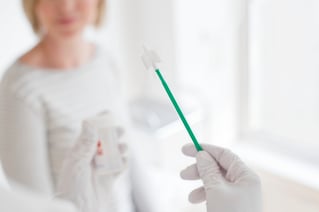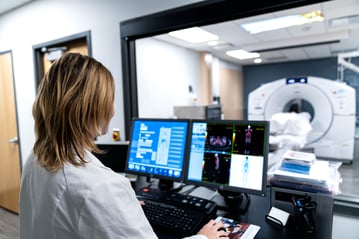What Does It Mean if You Need More Tests After a Cancer Screening?
6 min read

You’ll likely have many questions when abnormal cancer screening results come back. Do abnormal results mean you have cancer? Should you be worried? What happens next?
Try not to let your mind jump to conclusions. Abnormal or inconclusive cancer screenings do not necessarily mean that you have cancer. If it is cancer, the sooner it’s detected, the earlier it can be treated.
“Cancer is very time-sensitive,” said Dr. Jing Xi, MD, MPH, board-certified medical oncologist/hematologist at Rocky Mountain Cancer Centers. “Once you receive a diagnosis, you want to act right away.”
However, your doctor may want to take a closer look for many different reasons, depending on the type of cancer screening.
Getting Called Back After a Screening Mammogram
When you need additional tests after your routine screening mammogram, it’s no cause for alarm. Callbacks are common and happen for several reasons:
- The image lacks clarity. Sometimes, the mammogram isn’t clear enough, and your doctor needs a new one. This is particularly common for women with dense breast tissue. Having dense breast tissue means your breasts have more fibrous and glandular tissue than fat. The denser the breast tissue, the harder it is for doctors to see masses or other areas of abnormal tissue on a mammogram. Your doctor might need additional images to get a clearer picture.
- The doctor wants to take a closer look at a specific area. If the image shows calcifications or a mass, your doctor may need a more detailed view. These tiny calcium deposits within breast tissue may or may not be cancerous. Sometimes, your doctor might order a biopsy to rule out cancer if a calcification looks suspicious. A mass that shows up as an irregular shape in the breast tissue could either be a solid or a fluid-filled cyst. Your doctor might order an ultrasound to tell if a mass is a benign cyst or requires additional testing.
- It’s your first mammogram. Doctors often compare previous mammograms to see if unusual-looking areas of tissue are new or if they have shown up before. If it’s your first mammogram, your doctor may want to get another look because there is no previous image for comparison. This image also creates a baseline for future mammograms.
Whatever the cause for your callback, the American Cancer Society reports that fewer than 10% of women who have additional diagnostic tests are diagnosed with cancer. While it’s essential to make an appointment immediately if you are called back, remember that doctors usually need further imaging to rule out cancer, not find it.
Understanding Results of a Pap Test Cancer Screening
A Pap test reveals whether cells in the cervix are normal or abnormal. Remember that most people who get abnormal cervical cancer screening results do not have cancer. There are three possible outcomes for Pap test results:
- Normal/negative: The test showed no abnormal cells in the cervix.
- Abnormal/positive: This means that some of the cervical cells look unusual compared to the others. However, this doesn't necessarily mean that you have cancer. An abnormal result can mean that you have a human papillomavirus (HPV) infection. This sexually transmitted disease can cause cervical cancer. Abnormal cells can also be precancerous. Next steps include monitoring to see if they go away on their own or treating abnormal cells before they turn cancerous.
- Unsatisfactory/unclear: This result means that the test didn't yield a big enough cell sample or the cells were obscured by mucus or blood. Typically, your doctor will ask you to return for another test in 2 to 4 months.
If you have an abnormal Pap test, your doctor will likely follow up with one or more of the following tests:
 A colposcopy: The doctor uses a speculum and a device called a colposcope to examine your cervix and vagina closely.
A colposcopy: The doctor uses a speculum and a device called a colposcope to examine your cervix and vagina closely.- Cervical biopsy: The doctor takes a sample of cells from the cervix that will be examined under a microscope.
Receiving Results from a Lung Cancer Screening
If you are aged 50 to 80, have certain risk factors, including a history of smoking, and still smoke or have quit in the last 15 years, your doctor might encourage you to get an annual low-dose CT scan to screen for lung cancer. This scan takes several X-rays while you lie on a table that slides in and out of a special machine. Your doctor might ask you to come back for additional testing based on the results. Possible results include:
- Positive: This doesn’t necessarily mean you have cancer. However, the scan detected something abnormal, usually a nodule over a certain size.
- Negative: The test uncovered nothing abnormal. Your doctor will determine when or if you need another screening in the future.
- Indeterminate: This means that something abnormal may have been detected, but it is not yet of concern. Your doctor might recommend further testing in the future.
If your lung cancer screening is positive, your doctor will likely have you get additional testing. These might include:
 PET/CT scan: A positron emission tomography, or PET scan, is a type of nuclear imaging scan that uses a type of radioactive sugar. Cells in your body absorb different amounts of the sugar depending on the speed of their growth. Cancer cells grow quickly, so they are more likely to take in larger quantities of the sugar than healthy cells.
PET/CT scan: A positron emission tomography, or PET scan, is a type of nuclear imaging scan that uses a type of radioactive sugar. Cells in your body absorb different amounts of the sugar depending on the speed of their growth. Cancer cells grow quickly, so they are more likely to take in larger quantities of the sugar than healthy cells.- Fine-needle aspiration: This is a nonsurgical option in which the doctor uses a long, hollow needle to get a sample of cells from the abnormal area. The drawback to this test is that the doctor can only get a small number of cells, which isn’t always enough for all necessary laboratory tests.
Managing Your ‘Scanxiety’
Although most abnormal scan results don’t lead to a cancer diagnosis, additional testing can still trigger anxiety, or “scanxiety,” in many people. You may experience feelings of dread as well as fear of the unknown as you wait for your blood work or other test results to come back. You may also have trouble sleeping or eating and feel irritable or depressed.
It can help to know that these feelings are normal. You can also try the following techniques to manage stress and anxiety:
- Distract yourself: Keep yourself busy with activities you enjoy, such as doing favorite hobbies, watching movies, exercising, and spending time with family and friends.
- Meditate: Yoga and other meditation techniques can help you focus your mind and release negative thoughts.
- Share your feelings: Open up to those close to you about how you feel. You can also try writing in a journal or diary.
It can also help to devise a plan for how you will receive your test results. You might choose not to look at results on your electronic medical record and instead get them in person or over the phone from your doctor. Having a loved one with you for support can also help. If your test results lead to a cancer diagnosis, it’s also essential to get a second opinion in many cases.
Dr. Xi also encourages you to find a doctor who will listen to your concerns, answer all of your questions, and fully explain your treatment options so you can make the best decision on how to proceed.
“I value and respect a patient’s decision, as long as it’s completely informed, and the patient truly understands the pros and cons, good and bad, and consequences of his or her choice,” Dr. Xi said. “Then I will find the best way possible to satisfy the patient.”
If you have received a cancer diagnosis and want a second opinion, request an appointment with the experts at Rocky Mountain Cancer Centers.